Thomas Cole, View from Mount Holyoke, Northampton, Massachusetts, after a Thunderstorm — The Oxbow, 1836, oil on canvas, 51 1/2 x 76″ / 130.8 x 193 cm (The Metropolitan Museum of Art, New York City)
An American painter born in England
During the nineteenth century—an expanse of time that saw the elevation of landscape painting to a point of national pride—Thomas Cole reigned supreme as the undisputed leader of the Hudson River School of landscape painters (not an actual school, but a group of New York city-based landscape painters). It is ironic, however, that the person who most embodies the beauty and grandeur of the American wilderness during the first half of the nineteenth century was not originally from the United States, but was instead born and lived the first seventeen years of his life in Great Britain. Originally from Bolton-le-Moor in Lancashire (England), the Cole family immigrated to the United States in 1818, first settling in Philadelphia before eventually moving to Steubenville, Ohio, a locale then on the edge of wilderness of the American west.
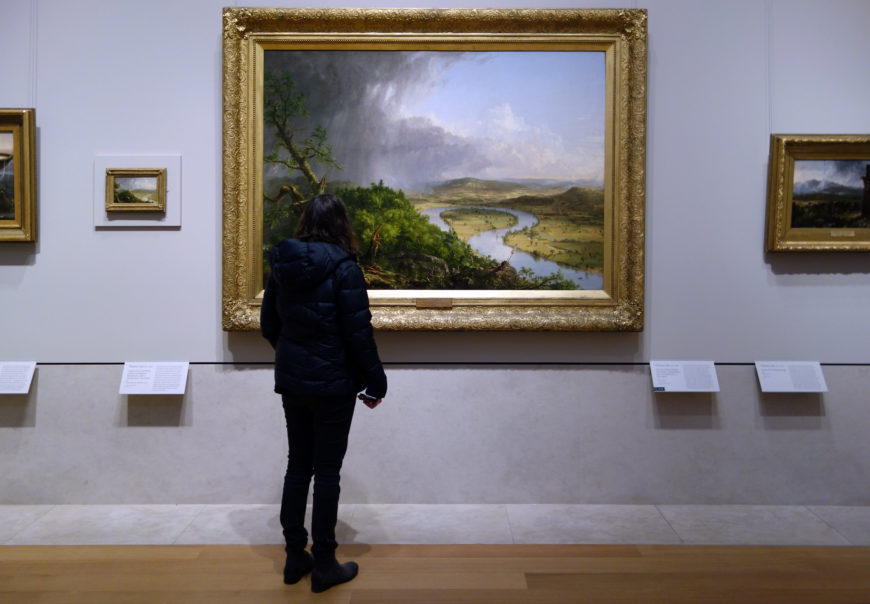
At The Metropolitan Museum of Art, looking at Thomas Cole, View from Mount Holyoke, Northampton, Massachusetts, after a Thunderstorm—The Oxbow, 1836, oil on canvas, 130.8 x 193 cm (The Metropolitan Museum of Art, photo: Steven Zucker, CC BY-NC-SA 2.0)
Early years
Cole worked briefly in Ohio as an itinerant portraitist, but returned to Philadelphia in 1823 at the age of 22 to pursue art instruction that was then unavailable in Ohio. Two years later, Cole moved to New York City where he exchanged his aspirations of painting large-scale historical compositions for the more reasonable artistic goal of completing landscapes. For instruction, Cole turned to a book, William Oram’s Precepts and Observations on the Art of Colouring in Landscaping (1810), an instructional text that had a profound effect on Cole for the remainder of his artistic career.
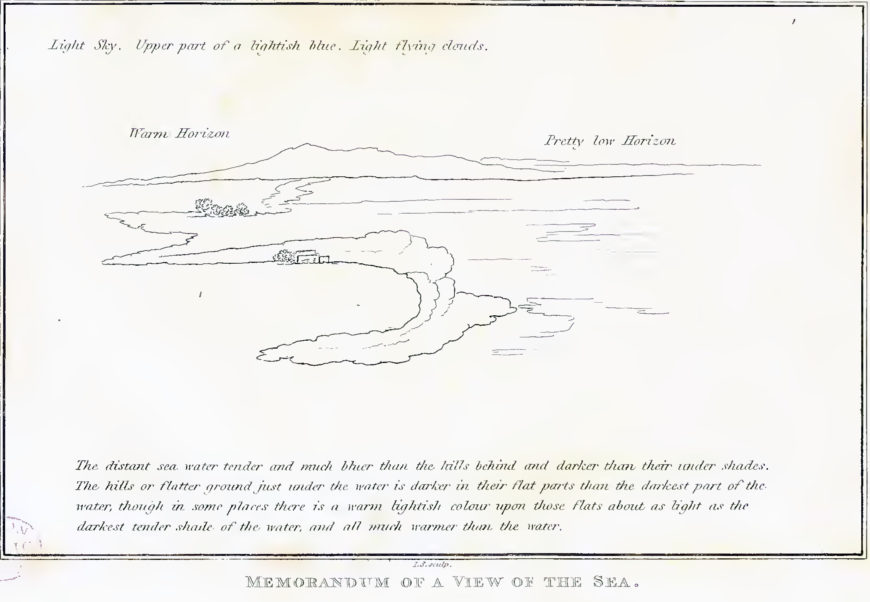
William Oram, Precepts and observations on the art of colouring in landscape painting (Charles Clarke, 1810)
An important ally and an influential patron
Cole found quick success in New York City. In the year of his arrival, 1825, John Trumbull, the patriarch of American portraiture and history painting, and the president of the American Academy of Design “discovered” Cole, and the older artist made it an immediate goal to promote the talented landscape painter. In the months to follow, Trumbull introduced Cole to many of the wealthy and prominent men who would become his most influential patrons in the decades to follow. One such man was Luman Reed, an affluent merchant who, in 1836, commissioned Cole to paint the five-canvas series The Course of Empire.
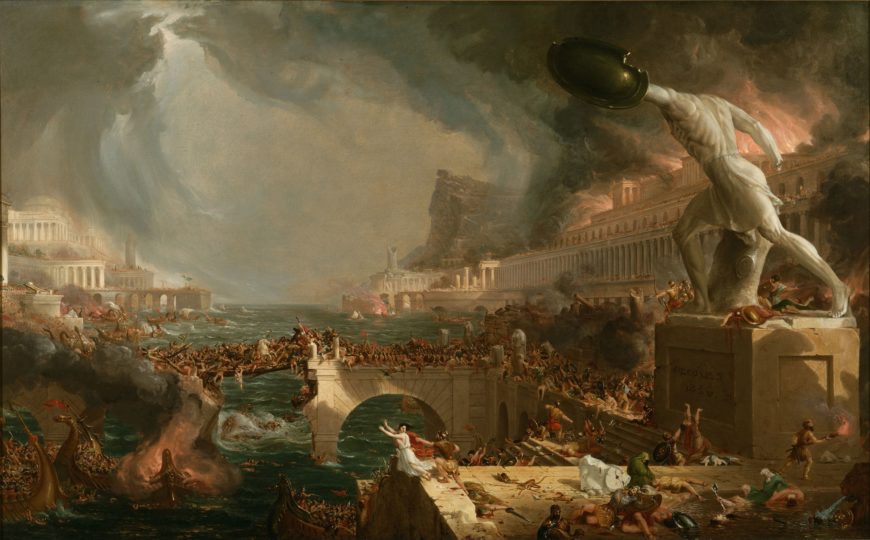
Thomas Cole, The Course of Empire: Destruction, 1833–36, oil on canvas, 39-1/2 x 63-1/2 inches (The New-York Historical Society)
Landscapes imbued with a moral message
It is in this series—and in many of the paintings to follow—that Thomas Cole found the aesthetic voice to lift the genre of landscape painting to a level that approached history painting. During the eighteenth and nineteenth centuries, great artists aspired to complete large-scale historical compositions, paintings that often had an instructive moral message. Landscape paintings, in contrast, were often though more imitative than innovative. But in The Course of Empire, Cole was able to take the American landscape and imbue it with a moral message, as was often found in history paintings. Indeed, the landscapes Cole began to paint in the 1830s were not entirely about the land. In these works, Cole used the land as a way to say something important about the United States.
The Oxbow: More than a bend in the Connecticut River
A wonderful illustration of this is Cole’s 1836 masterwork, A View from Mount Holyoke, Northampton, Massachusetts, after a Thunderstorm, a painting that is generally (and mercifully) known as The Oxbow. At first glance this painting may seem to be nothing more than an interesting view of a recognizable bend in the Connecticut River. But when viewed through the lens of nineteenth-century political ideology, this painting eloquently speaks about the widely discussed topic of westward expansion.
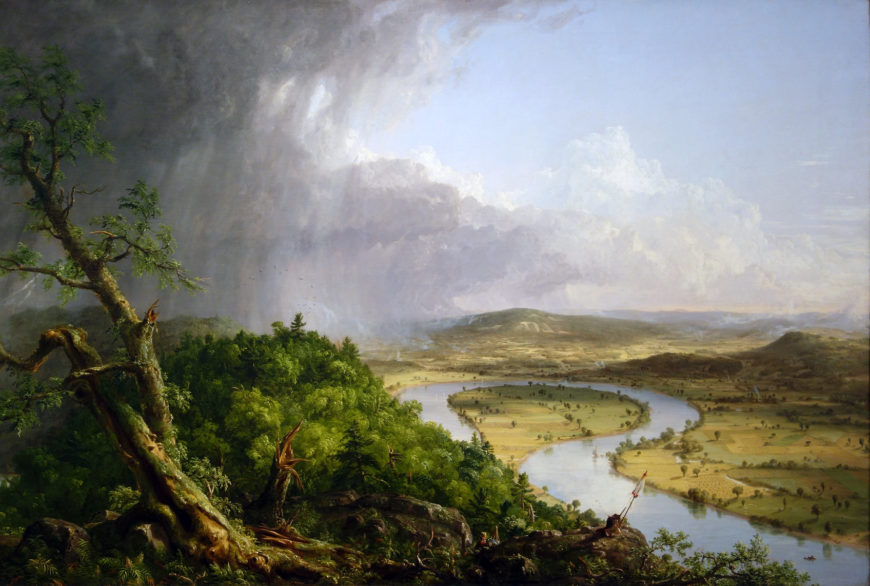
Thomas Cole, View from Mount Holyoke, Northampton, Massachusetts, after a Thunderstorm—The Oxbow, 1836, oil on canvas, 130.8 x 193 cm (The Metropolitan Museum of Art, photo: Steven Zucker, CC BY-NC-SA 2.0)
When looking at The Oxbow, the viewer can clearly see that Cole used a diagonal line from the lower right to the upper left to divide the composition into two unequal halves. The left-hand side of the painting depicts a sublime view of the land, a perspective that elicits feelings of danger and even fear. This is enhanced by the gloomy storm clouds that seem to pummel the not-too-distant middle ground with rain. This part of the painting depicts a virginal landscape, nature created by God and untouched by man. It is wild, unruly, and untamed.
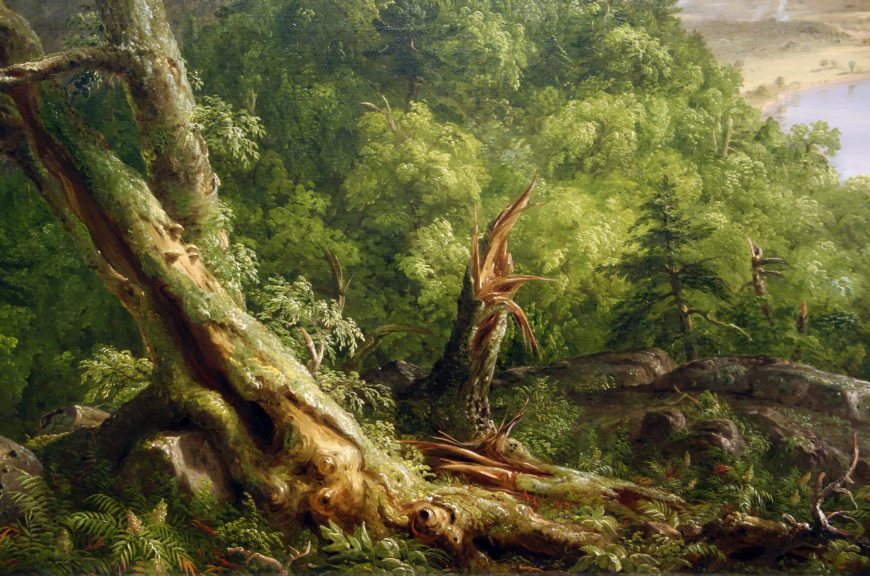
Blasted Tree (detail), Thomas Cole, View from Mount Holyoke, Northampton, Massachusetts, after a Thunderstorm—The Oxbow, 1836, oil on canvas, 130.8 x 193 cm (The Metropolitan Museum of Art, photo: Steven Zucker, CC BY-NC-SA 2.0)
Within the construction of American landscape painting, American artists often visually represented the notion of the untamed wilderness through the “Blasted Tree, a motif Cole paints into the lower left corner. That such a formidable tree could be obliterated in such a way suggests the herculean power of Nature.
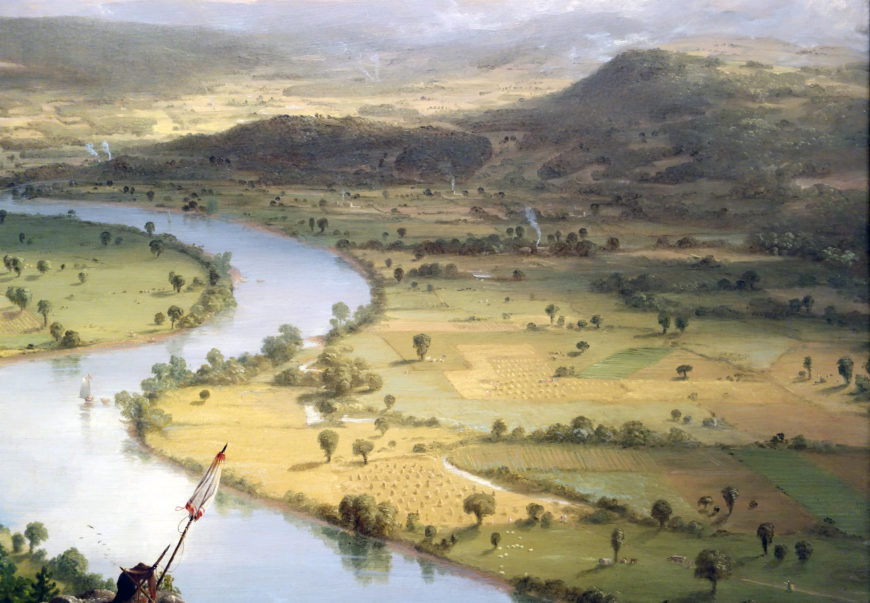
Pastoral landscape (detail), Thomas Cole, View from Mount Holyoke, Northampton, Massachusetts, after a Thunderstorm—The Oxbow, 1836, oil on canvas, 130.8 x 193 cm (The Metropolitan Museum of Art, photo: Steven Zucker, CC BY-NC-SA 2.0)
If the left side of this painting is sublime in tenor, on the right side of the composition we can observe a peaceful, pastoral landscape that humankind has subjugated to their will. The land, which was once as disorderly as that on the left side of the painting, has now been overtaken by the order and regulation of agriculture. Animals graze. Crops grow. Smoke billows from chimneys. Boats sail upon the river. What was once wild has been tamed. The thunderstorm, which threatens the left side of the painting, has left the land on the right refreshed and no worse for the wear. The sun shines brightly, filling the right side of the painting with the golden glow of a fresh afternoon.
Manifest Destiny
When viewed together, the right side of the painting—the view to the east—and that of the left—the west—clearly speak to the ideology of Manifest Destiny. During the nineteenth century, discussions of westward expansion dominated political discourse. The Louisiana Purchase of 1804 essentially doubled the size of the United States, and many believed that it was a divinely ordained obligation of Americans to settle this westward territory. In The Oxbow, Cole visually shows the benefits of this process. The land to the east is ordered, productive, and useful. In contrast, the land to the west remains unbridled. Further westward expansion—a change that is destined to happen—is shown to positively alter the land.
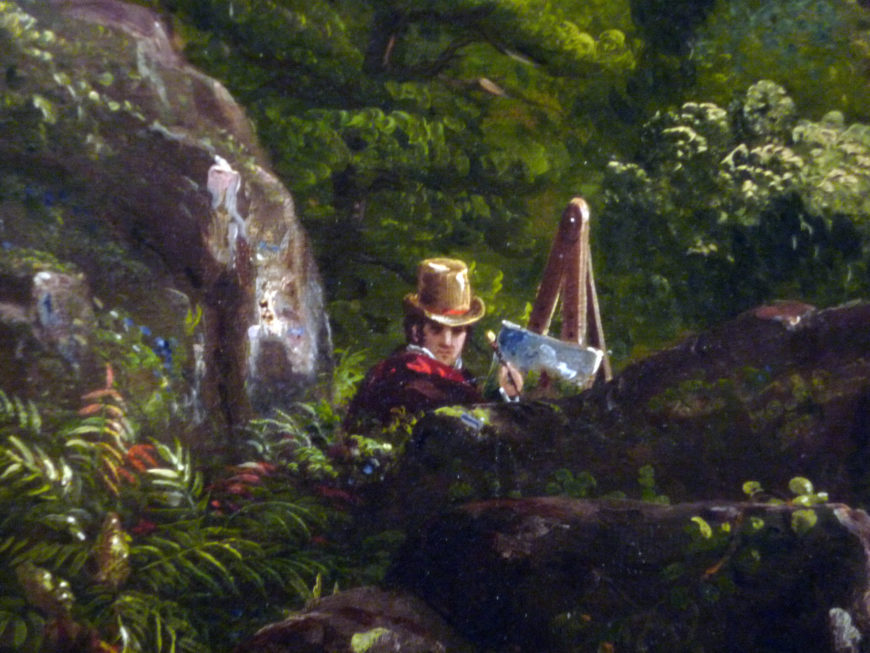
Self-portrait (detail), Thomas Cole, View from Mount Holyoke, Northampton, Massachusetts, after a Thunderstorm—The Oxbow, 1836, oil on canvas, 130.8 x 193 cm (The Metropolitan Museum of Art, photo: Steven Zucker, CC BY-NC-SA 2.0)
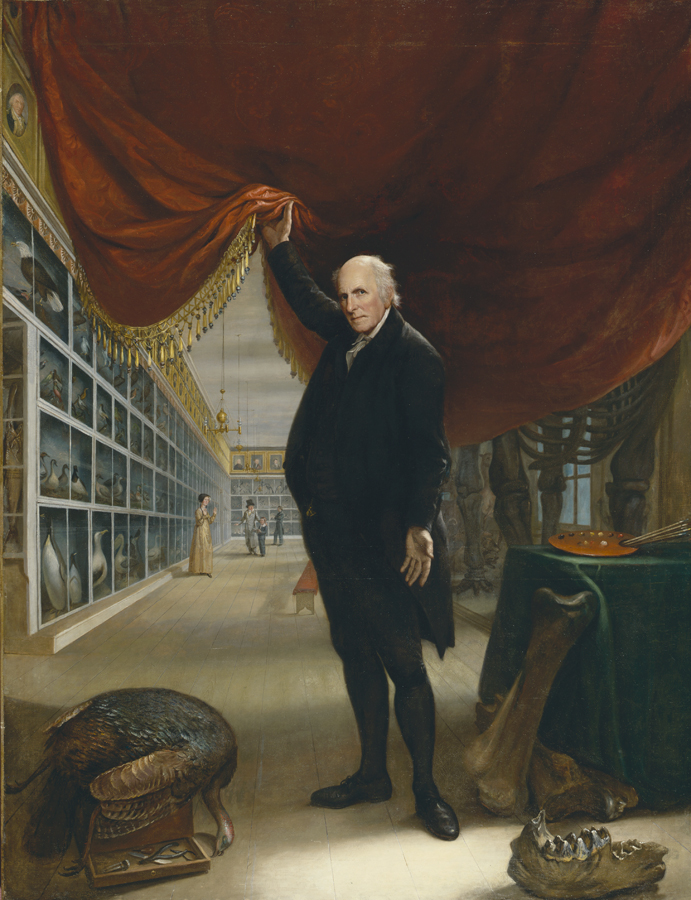
Charles Willson Peale, The Artist in His Museum, 1822, oil on canvas, 263.5 x 202.9 cm (Pennsylvania Academy of the Fine Arts)
Although Cole was the most influential landscape artist of the first half of the nineteenth century, he was not completely adverse to figure painting. Indeed, a close look at The Oxbow, reveals an easily overlooked self-portrait in the lower part of the painting. Cole wears a coat and hat and stands before a stretched canvas placed on an easel, paintbrush in hand. The artist pauses, as if in the middle of the brushstroke, to engage the viewer. This work, then, in a kind of “artist in his studio” self-portrait—is akin, in many ways, to Charles Willson Peale’s 1822 work The Artist in His Museum. In each, the artist depicts himself in his own setting. For Peale, this was his natural history museum in Philadelphia. For Cole, this was the nature he is most well known for painting.
Lasting influence
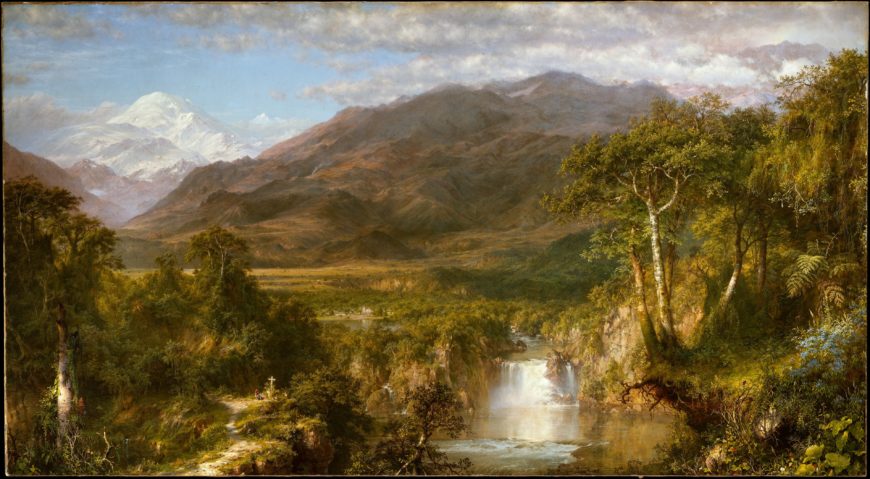
Frederic Edwin Church, Heart of the Andes, 1859, oil on canvas, 168 x 302.9 cm (The Metropolitan Museum of Art)
Although he only formally accepted one pupil for instruction—this was, of course, Frederic Edwin Church—Thomas Cole exerted a powerful influence on the course of landscape painting in the United States during the nineteenth century. Not content to merely paint the land, Cole elevated the landscape genre to approach the status of historical painting. The landscape painters who followed during the middle of the nineteenth century—Church, Durand, Bierstadt, and others—would often follow the trail that Cole had blazed.
Additional resources
This painting at The Metropolitan Museum of Art.
Cedar Grove, The Thomas Cole National Historic Site.
Hudson River School on The Metropolitan Museum of Art’s Heilbrunn Timeline of Art History.
Thomas Cole on The Metropolitan Museum of Art’s Heilbrunn Timeline of Art History.
On Cole’s The Course of Empire.
Smarthistory images for teaching and learning:
[flickr_tags user_id=”82032880@N00″ tags=”oxbow,”]
[0:00] [music]
Dr. Steven Zucker: [0:04] We’re in the Metropolitan Museum of Art, looking at Thomas Cole’s “View from Mount Holyoke, Northampton, Massachusetts, after a Thunderstorm — The Oxbow.”
Dr. Beth Harris: [0:14] We know it as “The Oxbow.”
Dr. Zucker: [0:15] It’s a Hudson River School painting by Thomas Cole, who’s credited with founding American landscape painting.
Dr. Harris: [0:22] Landscape painting was ranked very low by the academies in Europe.
Dr. Zucker: [0:27] Painting was ranked very low in American society.
Dr. Harris: [0:31] That’s true. When Americans did want paintings, they didn’t want grand mythological scenes, they wanted portraits, or landscapes, or views like this one.
Dr. Zucker: [0:41] This is a view of a well-known unusual natural scene, a place where the Connecticut River bends back on itself.
Dr. Harris: [0:48] This is a really large painting. I think it’s five or six feet wide and five feet high. That speaks to the importance that Thomas Cole wanted to give to landscape painting. Landscape painting, considered this lowly genre, but here made not only large in size, but Cole, even here in this view, trying to say something more with landscape.
[1:11] When we think of Thomas Cole, we think of “The Course of Empire” or “The Voyage of Life,” these moments when he tries to use landscape to say something big. Something big is hidden here, too.
Dr. Zucker: [1:22] This is really ambitious. It’s not just landscape. It’s about transformation. It’s about time. It’s about a metamorphosis.
Dr. Harris: [1:31] Well, it’s about America and what America is going to become.
Dr. Zucker: [1:35] On the left side, we see a storm-ravaged landscape. We see a broken tree. We see rain pouring down, birds that seem to be frantic as they fly through the sky. We can even make out a little bit of a lightning bolt at the extreme left.
Dr. Harris: [1:51] We have what art historians and art critics at the time even referred to as the sublime, an image of nature that is wild and untamed and frightening and awesome.
Dr. Zucker: [2:02] This untouched wilderness, this virgin forest, was seen in stark contrast to the built environment of old Europe. Here was a promise of the new. It was America as a new Eden.
Dr. Harris: [2:15] This is so different than what Cole gives us on the other side, which is Americans settling this virgin landscape, transforming it into cultivated plots of land, into areas to graze their livestock, into places to settle and build homes. The storm is passing. The sun is coming. There’s a sense that this settling of the land is something which is ordained by God, which is approved by God.
Dr. Zucker: [2:42] This is tied in with the American notion of Manifest Destiny, that Americans were meant to tame this landscape. That this was ours. In fact, at least one art historian has looked at the hill in the center of the painting and read in that Hebrew letters.
Dr. Harris: [2:59] When looked at from above and in reverse, from God’s viewpoint, they seem to read, from the Hebrew, the word “Shaddai,” which means “Almighty,” referring to God. That idea that this is God’s plan and God has blessed America.
Dr. Zucker: [3:14] In art historical terms, what this is is the transition from the sublime to the pastoral.
Dr. Harris: [3:19] Pastoral being a peaceful idea of landscape, of man inhabiting landscape with a sense of tranquility and peacefulness.
Dr. Zucker: [3:26] We can see that in all of these anecdotal vignettes that Cole gives us. If you look at the lower right corner of the painting, for instance, you can see a ferry that’s been carefully rendered. You can see people that have been let off at one side and people who are now crossing over to the other.
Dr. Harris: [3:41] And a pathway that goes down to some farmland and places where sheep are grazing. Our eye can travel up and back through the chimney stacks of a few houses here and there, up through a valley where the sun is shining between two hills, and up to those bright clouds, and the sunshine, and that sense of promise.
Dr. Zucker: [4:02] There’s also wonderful specificity that is very much meant to entertain and to represent the particularity of nature. If you look at the left side, you can see there’s fungus that’s growing out of the blasted tree trunk. You can just make out a bird on one of the blasted boughs. Probably the most fun is, at the bottom center of the canvas, the artist himself looking back at us.
Dr. Harris: [4:24] Next to him, just slightly up the hill, is his supplies: his umbrella that will shelter him, a portfolio, a chair.
Dr. Zucker: [4:31] That chair is also a cross. We understand not only the passage of time here, the transition from wilderness to a paradise that man is creating, but we also understand this all within a Christian context.
Dr. Harris: [4:43] His portfolio, which has his name on it, reads as the signature of this painting, [and] also reads as a tombstone for the artist. There is that sense of the passage of time. I want to go back to a word that you used a moment ago, that was “entertain.”
[4:57] Here we are, first half of the 19th century, there is a middle-class audience and a new rising merchant class from which Cole is drawing his patrons, but there is this real need to entertain, to exhibit these paintings and make them fun for people to look at. This is not complicated.
Dr. Zucker: [5:15] It’s not mythology.
Dr. Harris: [5:16] No. It’s something that everyday Americans could relate to and fall in love with.
[5:20] [music]

